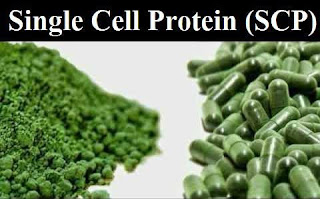Single Cell Proteins
Single cell protein in microbiology
The dried cells of microorganisms algae ,bacteria ,actinomyces and fungi used as food or feed are collectively known as microbial proteins . This term was replaced by new term single cell protein in 1967 during first International conference The another name of single cell protein is Microbial Biomass Protein or Bio Proteins or Bio Mass or Microbial Biomass
The term SCP was coined in 1966 by Carrol L Wilson of MIT.
The world’s demand of protein is approximately 180,000,000 tonnes out of which 82,000,000 tons is supplied from animals and vegetable sources out of these 40 million ton come from cereals and legumes and rest from animal proteins. In cereal’s protein ,there is lack of one or more essential amino acid .Example :beet lack lysine and maize lack and tryptophan, rice lack lysine and threonine,legumes lack methionine lysine and tryptophan .In order to meet these requirements of protein demand quantitatively as well as qualitatively ,attempts are being made to trap some cheap and alternative source of natural proteins. For this purpose, single cell protein is an ideal substitute in the hand of mankind.
Advantages of microbes in the production of single cell protein over the plant and animal sources of protein
• Microbes has very short generation.
• They have high protein content
• They grow rapidly. Bacteria reproduce within 24 hours , fungi within one to two days and yeast within 123 days.
• Microbes can be easily modified genetically to produce cells that bring about desirable results.
• They have simple nutritional requirements.
• In addition to proteins, they are good source of vitamins, fats and carbohydrates
• They grow on less expensive medium i.e on waste products.
• Single cell protein production does not depend upon season or climate. It can be produced in the extreme conditions. Some yeast can grow at night ,as they are the light independent microorganisms
• SCP production can even be done in infertile soil.
• Some microbes can fix nitrogen from the atmosphere as it does not depend upon the fertilizers or chemicals which are harmful to the environment or deteriorates public health.
Disadvantages of microbes
• They have high nucleic acid contents which leads to kidney’s stone production in human being called gout.
• Production of toxins and other harmful metabolic products by microbes during cultivation are harmful to human beings.
• Sometimes it produces unpleasant colour and flavour.
• Deficiency of methionine is due to some yeast and fungal proteins occur
• Contamination by other microorganisms should be controlled or prevent because contamination may produce toxins like mycotoxins or syn toxins
Microbes used for single cell protein production
There are the following microbes which are used for the production of single cell protein
Algae
Chlorella ,Spirulina, Laminaria
Fungi
Aspergillus oryzae, penicillium, Fusarium venenatum,Rhizopus
Bacteria
Nocardia ,E. coli,Rhodopseudo monas, Lactobacillus,Rhodobacter capsulatus
Yeast
Rhodotorulla, Candida utilis, C. arborea,Torulopsis, Saccharomyces.
Single cell protein from Algae
Advantages
• Since algae utilise sunlight and can grow on wasteland and often in ponds, so they can be easily cultivated
• They have 20 to 40% protein content
• They contain most of essential amino acids such as lysine and threonine but poor in content of methionine.
Single cell protein from Bacteria
Advantages
• They have rapid growth rate in comparison
• They have high protein content of 70 to 80%
Disadvantages
But bacteria have some disadvantages also for single cell protein these are as follows
• cells are smaller in size of low density which make their harvesting difficult and waste full
• Bacterial cells have high acid contents than yeast and fungi which is harmful to human being and production of citric acid poisoning gout in human beings.
Single cell protein from Yeast
Advantages
• Due to large size ,they are easier to harvest
• Having little or no adverse affect on animal system
Disadvantages
• lower growth rate
• low protein contents
Single cell protein from Fungi
Advantages
• They can grow on waste materials
• They are the good source of vitamin B-12 and riboflavin
Disadvantages
• Problems are encountered with the growth of fungal mycelium
• There is need of chemicals to avoid contamination due to bacteria
Present status of single cell protein in India
Single cell protein are good protein source in human and animals nutrition however its use in India is not much because of its complex products ,lack of awareness and establishment of bioconversion plants.
Main criteria
There are main criteria to be satisfied.
• The single cell protein must be safe to eat.
• The nutritional value must be high.
• It must be acceptable to public.
• it must have functionality.
• The economic viability of single cell protein process is extremely complex and yet to be demonstrated.
Substrate and microbes used
As the production of single cell protein takes place in a fermentation process and is done by some selected strains of microorganisms. These microorganisms multiplied on the suitable substrate ,in a technical cultivation process allowed to grow and the bio mass then followed by separation processes. Therefore there are the following substrate and the microorganisms used for the single cell proteins production.
Wheat straw as substrate
The microorganism used is Chaetimium cellulolyticum
Rice straw as substrate
The microorganism used is Cellulomonas
For corn cobs
The microbe used are B.subtilis, A.niger
For soyabean
The microbe used is Rhodopseudomonas
For petroleum waste
The microbe used Enterobacter aerogens.
For whey
C.utilis, S.cerevisiae









0 Response to "Single Cell Proteins"
Post a Comment